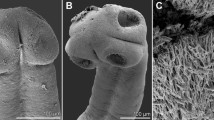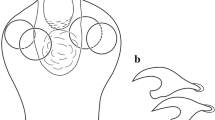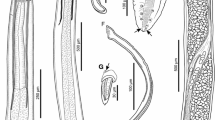Abstract
Nine specimens of Apus affinis (J.E. Gray) were studied at Franceville, Haut-Ogooué Province, Republic of Gabon, for the presence of helminth parasites. Two cestode species of the family Dilepididae were recorded. Pseudangularia gonzalezi n. sp. is distinguished from the most similar species P. europaea Georgiev & Murai, 1993 by having elliptical cirrus-sac, longer vagina, longer rostellar sheath and greater diameter of suckers. An identification key to the species of the genus Pseudangularia Burt, 1938 is proposed. The present study is the first record of the genus Pseudangularia in the Afrotropical Region. Our study confirms that, in dilepidids with vaginal sclerites from swifts, breaking off the cirrus after copulation is a frequent phenomenon. The genus Gibsonilepis n. g. is erected as monotypic for Vitta swifti Singh, 1952 (originally described from the same host species in India) and Gibsonilepis swifti n. comb. is proposed. Gibsonilepis n. g. is distinguished from Vitta Burt, 1938 by its highly elongate rostellum, rostellar sheath much bigger than rostellum, relatively small rostellar hooks possessing strongly developed guard, disc-shaped suckers with weak peripheral musculature and flat or convex central part, long and well-expressed neck, highly lobed two-winged ovary (lobes rounded) and presence of a band consisting of rows of spine-like microtriches along posterior margin of each proglottis. This is the first record of G. swifti in the Afrotropical Region. The separation of G. swifti from the genus Vitta (parasites of swallows) suggests that, contrary to previous opinions, no dilepidid genera are shared by Apodidae (swifts) and Hirundinidae (swallows).








Similar content being viewed by others
References
Baer, J.-G. (1959). Helminthes parasites. In: Explorations des Parcs Nationaux du Congo Belge. Mission J. G. Baer – W. Gerber. Fascicule 1. Brussels: Institut des Parcs Nationaux du Congo Belge, 163 pp.
Bona, F. V. (1994). Family Dilepididae Railliet & Henry. In: Khalil, L. F., Jones, A., & Bray, R. A. (Eds) Keys to the Cestode Parasites of Vertebrates. Wallingford, UK: CAB International, pp. 443–554.
Borgarenko, L. F. (1990). [The first record of cestodes of the genus Pseudangularia (Cyclophyllidea: Dilepididae) in swifts in Tajikistan.] Parazitologiya, 24, 85–88 (In Russian).
Burt, D. R. R. (1938). New avian cestodes of the family Dilepididae from Collocalia unicolor unicolor (Jerd.), the Indian Edible-nest Swiftlet, with descriptions of Pseudangularia thompsoni, P. triplacantha gen. et spp. nov. and Notopentorchis collocaliae gen. et sp. nov. Ceylon Journal of Science, Section B, Zoology and Geology, 21, 1–14.
Dollfus, R.-P. (1958a). Miscellanea Helminthologica Maroccana XXV. Sur quelques fragments de deux espèces de Dilepididae (Cestodes) à appareil occlusif chitinoïde, parasites de l’intestin d’Apus pallidus brehmorum Hartert. Archives de l’Institut Pasteur du Maroc, 5, 504–539.
Dollfus, R.-P. (1958b). Miscellanea Helminthologica Maroccana XXXI. Sur deux espèces de Dilepididae de l’intestin d’Apus pallidus brehmorum Harlet 1901. Archives de l’Institut Pasteur du Maroc, 5, 587–609.
Galkin, A. K. (1983). [Cestodes of the common swift (Apus apus L.) of the Kurish Spit.] Trudy Zoologicheskogo Instituta AN SSSR, 121, 57–67 (In Russian).
Georgiev, B. B., & Bray, R. A. (1988). Cestodes of the genera Angularella Strand, 1928 and Vitta Burt, 1938 from the Collection of the British Museum (Natural History). Systematic Parasitology, 12, 61–75.
Georgiev, B. B., & Murai, É. (1993). Pseudangularia europaea sp. n. and other cestodes (Cyclophyllidea: Dilepididae and Paruterinidae) from the common swift, Apus apus L. (Aves: Apodiformes) in Hungary. Parasitologia Hungarica, 26, 15–26.
Howard, R., & Moore, A. (1980). A complete checklist of the birds of the World. Oxford: Oxford University Press, 701 pp.
Illescas-Gomez, M. P., & Lopez-Roman, R. (1980). Nuevos parasitos cestodes de Apus apus L. en España. Revista Ibérica de Parasitologia, 40, 57–67.
Jadhav, B. V., Shinde, G. B., Gharge, D. M., & Gavhane, A. B. (1992). A review of the genus Mehdiangularia Shinde, 1969 (Cestoda: Dilepididae) at Aurangabad (M.S.). Indian Journal of Helminthology, 44, 85–92 (Cited after CABI Direct).
Kayton, R. J., & Kritsky, D. C. (1984). Sureshia trychopea sp. n. (Cestoda: Dilepididae) from white-throated swifts, Aeronautes s. saxatalis, (Aves: Apodiformes) with notes on dilepidine cestodes having a vaginal sclerite. Proceedings of the Helminthological Society of Washington, 51, 305–308.
Macko, J. K., & Rysavy, B. (1982). Vitta crotophagae sp. n. (Cestoda: Dilepididae), a new cestode species from Crotophaga ani L. in Cuba. Folia Parasitologica, 29, 297–301.
Matevosyan, E. M. (1963). [Dilepidoidea – tapeworms of domestic and wild animals.] In: Skryabin, K. I. (Ed.) [Principles of Cestodology, Vol. 3]. Moscow: Izdatel’stvo Akademii Nauk SSSR, 688 pp (In Russian).
Mhakse, D. K., Suryawanshi, S. G., Shinde, G. B., & Pawar, S. B. (2010). A new cestode Mehdiangularia affinisae (Eucetoda: Dilepididae) from Apus affinis, M.S., India. The Asian Journal of Animal Science, 5, 30–32.
Mokhehle, C. N. C. (1951). Parasites of the swift Caffrapus caffer caffer (Roberts) with description of one new genus and eight new species. Fort Hare Papers, 1, 326–383.
Salamatin, R. V. (1999). New cestode species from terrestrial birds from the fauna of Ukraine. Vestnik Zologii, 33, 100 (In Russian).
Shinde, G. B. (1969). Mediangularia [sic] swifti gen. et sp. nov. from the common house swift Apus affinis in India. Zoologischer Anzeiger, 182, 453–456.
Singh, K. S. (1952). Cestode parasites of birds. Indian Journal of Helminthology, 4, 1–72.
Spasskaya, L. P. (1973). [Alcataenia gen. n. (Cestoda: Dilepididae).] Parazity Zhivotnykh i Rasteniy, 6, 12–14 (In Russian).
Spasskaya, L. P., & Spasskii, A. A. (1971). [Cestodes of birds of Tuva.] Kishinev: Izdatel’stvo “Shtiinza”, 252 pp (In Russian).
Spasskaya, L. P., & Spasskii, A. A. (1977). [Cestodes of Birds in the USSR. Dilepididae of terrestrial birds.] Moscow: Izdatel’stvo “Nauka”, 300 pp (In Russian).
Spasskii, A. A., & Spasskaya, L. P. (1959). [Cestodes of swifts and swallows, phylogenetically distant but ecologically similar birds.] Helminthologia, 1, 85–98. (In Russian).
Spasskii, A. A., & Spasskaya, L. P. (1966). [Critical analysis of the genera Vitta and Neoliga (Cestoda: Dilepididae).] Izvestia Akademii Nauk Moldavskoy SSR, 1, 3–13. (In Russian).
Spassky, A. A. [Spasskii, A. A.] (2002). Neoliginae, subfam. n. (syn. tr. Neoligini Spassky, 1980), a new subfamily of cyclophyllidean cestodes. Acta Zoologica Lituanica, 12, 86–89.
Suryawanshi, V. M., & Jadhav, B. V. (1990). On Mehdiangularia Shinde, 1969 with report on a new species M. udgirensis sp. nov. (Cestoda: Dilepididae) from the common house swift, Apus affinis in India. Indian Journal of Parasitology, 14, 89–92 (Cited after CABI Direct).
Yamaguti, S. (1959). Systema helminthum. Volume 2. The cestodes of vertebrates. New York: Interscience Publishers Inc., 860 pp.
Acknowledgements
The identification of the swifts was confirmed by the ornithologist Dr Alice Cibois (Natural History Museum, Geneva). Dr Pavel Nikolov participated in the field studies together with two of the present authors. We are grateful to Dr Jean-Paul Gonzalez, Director General of the Centre International de Recherches Médicales de Franceville, Republic of Gabon, and the staff members of this research institute, for their support and hospitality during field studies. The senior author acknowledges the advice by Dr Yasen Mutafchiev, Dr Plamen Pankov and Dr Milka Elshishka in the course of the preparation of illustrations. We are grateful to Dr Gergana Vasileva for reading the manuscript. The present study used facilities developed at the Institute of Biodiversity and Ecosystem Research, Bulgarian Academy of Sciences, in the frames of the projects WETLANET (EC FP7, Programme CAPACITIES, Grant 229802) and CEBDER (National Science Fund of the Republic of Bulgaria, Grant DOO2-15/17.02.2009). This work was funded by the National Science Foundation, PBI grants DEB 0818696 and DEB 0818823.
Author information
Authors and Affiliations
Corresponding author
Rights and permissions
About this article
Cite this article
Dimitrova, Y.D., Mariaux, J. & Georgiev, B.B. Pseudangularia gonzalezi n. sp. and Gibsonilepis swifti (Singh, 1952) n. g., n. comb. (Cestoda, Dilepididae) from the House Swift, Apus affinis (J.E. Gray) (Aves, Apodiformes) from Franceville, Republic of Gabon. Syst Parasitol 86, 215–233 (2013). https://doi.org/10.1007/s11230-013-9445-4
Received:
Accepted:
Published:
Issue Date:
DOI: https://doi.org/10.1007/s11230-013-9445-4




